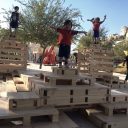


The commercialisation of child friendly cities and other challenges
During the upcoming Child in the City seminar in Antwerp, Sven De Visscher will be part of the roundtable discussion on qualitative vertical housing environments for children. In this interview, Sven gives us insight into his work,...Read more
Protecting our thirsty urban trees from more harsh summers
Urban forests are great for keeping our cities cool, but as temperatures go up they need water to survive – and that’s where redirecting storm water to street trees comes in. With increasing heat in the...Read more
What if children design their cities?
Kent ve Cocuk (City and Children) is a Turkish-based ‘urbanism’ initiative using 3D modelling workshops to see how children would design their own cities. The team of three urban planners and an architect came together in...Read more
Ankita Chachra joins the Child in the City World Conference keynote line-up
Urban designer Ankita Chachra is the third and final keynote speaker for the Child in the City World Conference in Vienna. She will share child-focused strategies and design guidance to inspire leaders, inform practitioners, and empower communities...Read more
Creating child-friendly smart cities with urban redevelopment
Singapore’s government is moving towards building a ‘Smart Nation’ by delivering a host of innovations to redesign public spaces such as bus stops with child-friendly features. Public wi-fi and interactive boards are just some of the...Read more
Increasing child road safety with the 2020 Action Agenda
Halving child road deaths in the next five years is a key aim of the 2020 Action Agenda, a global plan of action signed by Governments around the world. It is a product of the...Read more
Playscapes: pop up playground for children in cities
A pair of urban specialist architects has been inspired to use portable wooden crates to turn empty public spaces in the Jordanian capital Amman into playgrounds. Sarah Abdul Majid and Sandra Hiari, the brains behind...Read more
Hong Kong needs inclusive playgrounds for disabled children
A pilot study reveals a number of existing playgrounds in Hong Kong lack inclusive facilities that cater to the needs of disabled children. The research also highlights obstacles and opportunities for change. Researchers found no...Read more
Let’s enrich public space – especially in poor neighbourhoods
Redesigning public space can transform the feel of a neighbourhood, but sometimes the expense, though modest, can inhibit the aspiration of the residents who need it most. Nadine Roos reflects on what may be the true cost...Read more
Everything to play for
Introducing more play space to cities can help tackle health, societal and environment issues, says Samuel Williams of the planning and design specialists, Arup. We need to take play seriously. We need to take play seriously...Read more
Beyond home: the urban environment through the eyes of children
A research project in a Montreal suburb highlights the dearth of child-friendly environments within children’s own neighbourhoods, write Swathika Anandan and Malaka Ackaoui of McGill University, Canada. Children are among of the primary users of the cities we live in....Read more
Age diversity for social cohesion
Creating public space that encourages social integration has never been more important. Here, Samuel Williams of planning specialists Arup, explains why child-friendly cities must adopt inter-generational design principles. ‘Designing cities for all’ is easy to say but if...Read more
Incorporating play into pedestrian walkways
When it comes to designing narrow public spaces such as street sidewalks, pedestrian bridges and pathways in general, designers are often forced by the functional and spatial constraints to discard play as a priority. However,...Read more
10 ways to build a city for children
The Vancouver-based urbanist, Jillian Glover, an advisor to the Canadian government who runs the ‘This City Life’ blog-site, has identified the ten features that she believes are the key to building child-friendly cities. Suggesting that,...Read more

